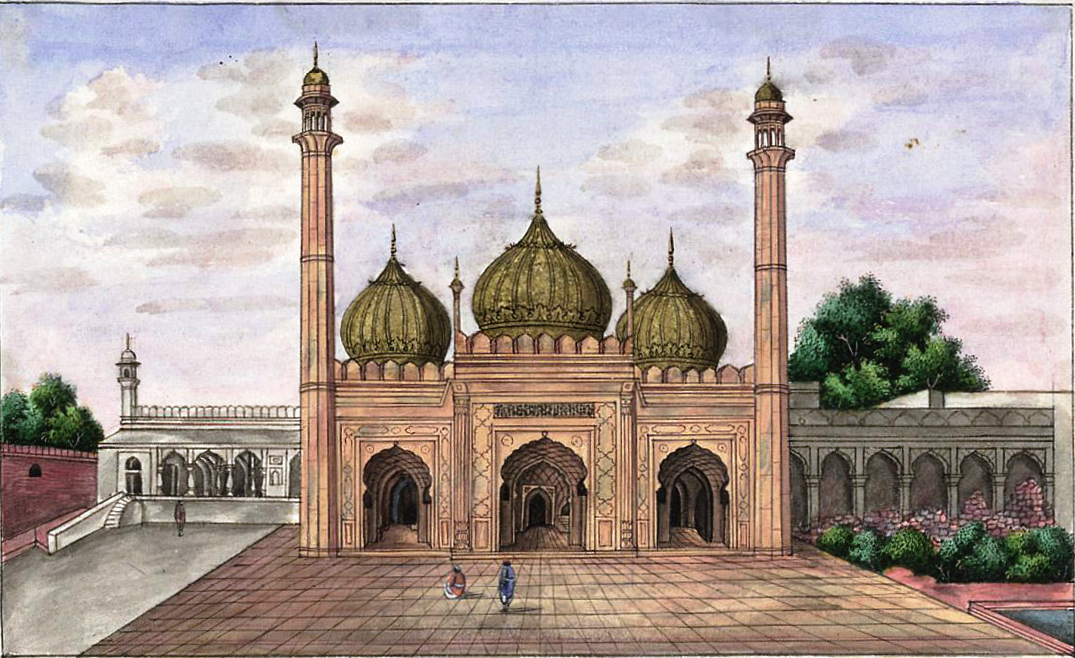Sunehri Masjid (Red Fort) on:
[Wikipedia]
[Google]
[Amazon]
 The Golden Mosque, or Sunehri Masjid, is a mosque in Chandni Chowk of
The Golden Mosque, or Sunehri Masjid, is a mosque in Chandni Chowk of
 The Golden Mosque, or Sunehri Masjid, is a mosque in Chandni Chowk of
The Golden Mosque, or Sunehri Masjid, is a mosque in Chandni Chowk of Old Delhi
Old Delhi or Purani Dilli is an area in the Central Delhi district of Delhi, India. It was founded as a walled city named Shahjahanabad in 1648, when Shah Jahan (the Mughal emperor at the time) decided to shift the Mughal capital from Agra. T ...
. It is located outside the southwestern corner of Delhi Gate of the Red Fort
The Red Fort or Lal Qila () is a historic fort in Old Delhi, Delhi in India that served as the main residence of the Mughal Emperors. Emperor Shah Jahan commissioned construction of the Red Fort on 12 May 1638, when he decided to shift ...
, opposite the Netaji Subhash Park.
History
The mosque was constructed between 1747 and 1751 by the order ofQudsia Begum
Qudsia Begum, born Udham Bai ( 1768) was a wife of Mughal emperor Muhammad Shah and mother of emperor Ahmad Shah Bahadur. She was an administrator and served as de facto regent of India from 1748 to 1754.
Early years
A Hindu by origin, Udham Bai ...
for Nawab Bahadur Javed Khan, a nobleman during the reign of the Emperor Ahmad Shah Bahadur. Qudsia Begum was the mother of Emperor Ahmad Shah Bahadur. Javed Khan was the supervisor of the harem and was in great favour with the begum and therefore was very influential. He was later assassinated. The Sunehri Masjid is made of ''bassee jung'', a light salmon-coloured stone not usually used for building mosques, which gives the building a singular and picturesque appearance.
Nawab Ahmad Bakhsh Khan, father of the Nawab of Firozpur
Firozpur, also known as Ferozepur, is a city on the banks of the Sutlej River in Firozpur District, Punjab, India. After the partition of India in 1947, it became a border town on the India–Pakistan border with memorials to soldiers who ...
, repaired the mosque to benefit the neighbourhood. Not long after its renovation, Nawab Ahmad Bakhsh Khan was attacked by an infuriated elephant while out with his son. His horse was killed in the attack, and his vehicle was destroyed. The Nawab and his son were only saved from death by taking refuge inside this mosque.
Architecture
The mosque is surmounted by three domes, which were originally gilt with copper from which it derives its name. The mosque has a main prayer hall and two minarets. The central arch of the mosque bears an inscription about the builder of the mosque and date of its construction. In 1852, Bahadur Shah II had the mosque repaired and replaced the copper plates of the domes with sandstone facing.See also
*Qudsia Bagh
Qudsia Bagh (English: ''Qudsia Garden'') is an 18th-century garden complex and palace located in Old Delhi, India.
History
The complex was constructed in 1748 for Qudsia Begum, the mother of Mughal emperor Ahmad Shah Bahadur. It is situa ...
* Sunehri Masjid (Chandni Chowk)
The Sunehri Masjid () is an 18th-century mosque in Old Delhi. It was built by Mughal noble Roshan-ud-Daula, during the reign of Mughal Emperor Muhammad Shah. It is located near the Gurudwara Sis Ganj Sahib in Chandni Chowk, once an imperial bo ...
* Sunehri Masjid (Lahore)
References
External links
{{Mosques in India Mosques in Delhi Mosque buildings with domes Red Fort Mosques completed in 1751 1751 establishments in India Mughal mosques Monuments of National Importance in Delhi